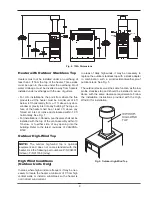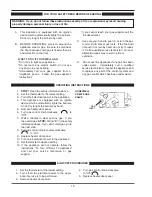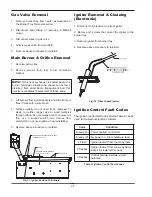
10
Indoor Installation
The heater is design-certified for indoor installation
when equipped with the approved drafthood.
Locate heater as close as is practical to a chimney or
gas vent. Heater must always be vented to the out-
side. See Vent Piping section for details. Minimum
allowable space is shown on the nameplate. Follow
the installation instructions provided with the Indoor
Drafthood Kit for installation.
Indoor Drafthood
Combustion & Ventilation Air
(Indoor Units Only)
The heater must have both combustion and ventilation
air. Minimum requirements for net free air supply
openings are one opening that is 12 inches from the
ceiling for ventilation, and one opening that is 12 inch-
es from the floor for combustion air as outlined in the
latest edition of the National Fuel Gas Code, ANSI
Z223.1(Canada-CAN/CSA-B149) and any local codes
that may have jurisdiction.
NOTE:
For Canada, indoor installation is restricted
to an enclosure that is not occupied and does not
directly communicate with an occupied area. Refer
to the latest edition of CAN/CSA-B149 for specific
requirements.
Indoor
Drafthood
Fig. 6: Indoor Drafthood
NOTE:
The indoor drafthood is optional equipment
and does not come standard with the heater. Use the
following part number: P/N 003723.
All Air From Inside the Building
Each opening shall have a minimum net free area of
130 sq. in.
All Air From Outdoors
When air is supplied directly from outside of building,
each opening shall have a minimum net free area of
33 sq. in.
Vent Piping
Vent piping the same size as the drafthood outlet is
recommended, however, when the total vent height is
at least 10 ft (drafthood relief opening to vent terminal),
the vent pipe size may be reduced as specified in the
National Fuel Gas Code, ANSI Z223.1 (Canada -
CAN/CSA-B149). As much as possible, avoid long
horizontal runs of vent pipe and too many elbows.
If installation requires horizontal runs, the vent pipe
must have a minimum of 1/4 in. per ft rise and should
be supported at not more than five foot intervals.
Plumbers tape, criss-crossed, will serve to space
both horizontal and vertical piping. Gas vents support-
ed only by the flashing and extending above the roof
more than five feet should be securely guyed or
braced to withstand snow and wind loads. We recom-
mend use of insulated vent pipe spacers through the
roof and walls.
For protection against rain or blockage by snow, the
vent pipe must terminate with a vent cap which com-
plies with local codes or, in the absence of such codes,
the latest edition of the National Fuel Gas Code, ANSI
Z223.1 (Canada - CAN/CSA-B149).
The discharge opening must be a minimum of 2 ft ver-
tically from the roof surface and at least 2 ft higher than
any part of the building within 10 ft. Vent stack shall be
at least 5 ft in vertical height above the drafthood out-
let. The vent cap location shall have a minimum
clearance of 4 ft horizontally from, and in no case
below, unless a 4 ft horizontal distance is maintained,
from electric meters, gas meters, regulators and relief
equipment.
CAUTION:
Combustion air must not be
contaminated by corrosive chemical fumes which
can damage the heater and void the warranty. Do
not store chlorine, bromine, baquasil or acid in the
same room as the heater.











































